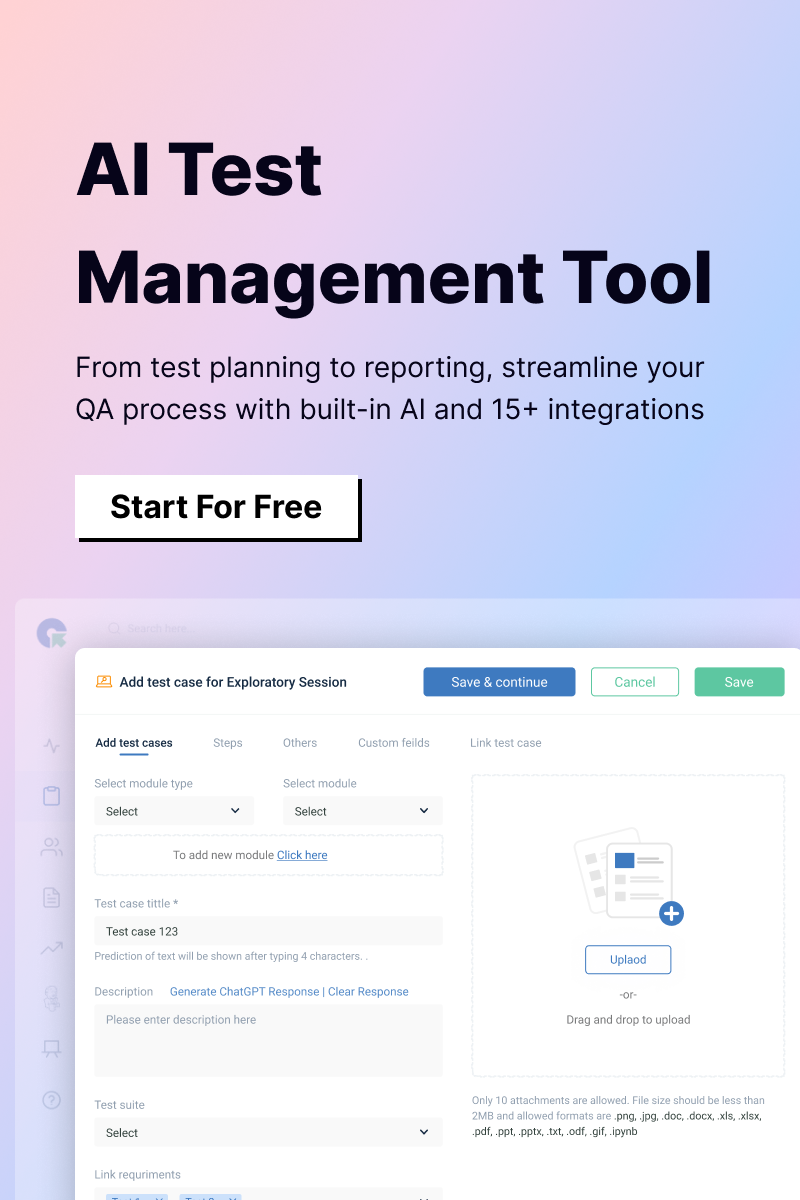Imagine this- you’re building an app. You’ve got all the requirements listed, your design looks solid, and the code is coming along. But how do you know if you’re building it right? And more importantly, how do you know if you’re building the right thing?
That’s where Verification and Validation come into play. Verification is about building the software or application correctly. While Validation means whether you are building the correct software or application. In this blog, we will learn in detail about verification and validation. So, let’s begin.
What Is Verification Testing?
Verification testing means the software is built correctly following the specified design and requirements. You’re not running the software here. You’re reviewing, inspecting, and analyzing to confirm that everything is being developed according to the design documents, technical specs, and requirements you’ve laid out.
In other words, you’re asking: “Did we build it correctly?”
The primary goal of verification testing is to catch any mistakes early in the development process before the code is even executed. It helps you stay aligned with the original plan, reduce the chances of costly fixes later, and ensure the software architecture and logic are sound from the get-go.
Advantages Of Verification Testing
Alt text: Advantages of verification testing
Verification plays a crucial role in software testing. Here are some of the advantages it has to offer:
Ensures Alignment with Design and Requirements
Verification testing confirms that the software is being built according to the predefined specifications, design documents, and requirements shared by stakeholders. This helps ensure that development stays on the right track and avoids costly deviations from the intended functionality.
Early Detection of Errors and Defects
One of the primary benefits of verification testing is the ability to catch bugs, inconsistencies, and design flaws early in the development cycle. By identifying issues at an early stage, teams can address them before they escalate into larger problems, saving time and resources.
Reduces the Risk of Costly Rework
Verification testing significantly reduces the chances of needing extensive rework later in the project by catching errors early and confirming that the development is progressing as planned. This not only lowers development costs but also shortens timelines.
Enhances Overall Software Quality
Verification testing contributes to building a more stable and reliable product through systematic checks and validations. It ensures that each software component meets the required standards, leading to a higher-quality final release.
When To Perform Verification Testing In SDLC?
Verification testing is performed at multiple stages throughout the Software Development Life Cycle (SDLC) to ensure the product aligns with requirements and specifications.
- Verification testing can begin even before any code is written. At this stage, design documents, requirement specifications, and system architecture are reviewed to ensure they meet the business needs and are technically feasible.
- Once a specific module or component is developed, verification testing checks whether it behaves as intended and complies with the design and coding standards. This helps isolate and resolve issues early.
- When different modules are integrated, verification testing ensures that they interact correctly and that the system as a whole functions as expected based on the original design.
- Any time modifications are introduced. Whether through enhancements, bug fixes, or refactoring, verification testing ensures the changes align with the requirements and don’t introduce new errors.
- Software updates, especially those that affect core functionality, require verification testing to ensure that the updated version still meets the initial specifications and hasn’t broken existing features.
- Prior to handing the product over for UAT, verification testing confirms that all requirements have been met and that the product is ready for user validation. This acts as a final checkpoint to catch any critical issues.
Verification Testing Process
Verification testing is a systematic approach used to ensure that software development outputs align with specified requirements and design. Here’s a breakdown of the key steps in the verification testing process:
Review and Analyze Software Requirements
The process begins with a thorough review of the software requirements. The goal is to ensure they are clear, complete, and unambiguous. Ambiguities or missing details are flagged early to avoid misinterpretations during development.
Examine the System Design Against Requirements
Next, the system design is evaluated to confirm that it accurately reflects the defined requirements. This includes both high-level and low-level design documents. The goal is to ensure that the architecture and proposed solutions are aligned with what the software is intended to do.
Inspect Source Code (Static Analysis)
Source code is reviewed without being executed. This step focuses on identifying syntax errors, compliance with coding standards, and potential logical flaws. Code inspections, peer reviews, and static analysis tools are commonly used here.
Validate Specifications and Documentation
All related documentation, including functional specs, test plans, and design documents is checked for correctness, consistency, and alignment with requirements. This step helps maintain traceability and supports later testing phases.
Conduct Team-Based Evaluations
Collaborative reviews such as walkthroughs and inspections are conducted by cross-functional teams. These evaluations cover various artifacts, including architecture designs, interface definitions, and test cases. The diverse perspectives help identify gaps or weaknesses that may be missed in solo reviews.
What Is Validation Testing?
Validation testing is a crucial phase in the software development life cycle focused on evaluating whether the final product meets the end-user’s needs and performs as expected in a real-world environment. While verification testing ensures the product is built right, validation testing ensures the right product is built.
In simple terms, validation testing answers the question: “Did we build what the user actually wants?”
Validation testing verifies that the software behaves in a way that matches user expectations and business needs, ensuring it delivers the intended value.
Advantages of Validation Testing
Validation testing plays a vital role in ensuring the software is not only functionally correct but also practical, usable, and aligned with user expectations. Below are some of the key advantages:
Catches Bugs Missed During Verification
While verification testing focuses on design and code-level issues, validation testing involves executing the application in real-world scenarios. This helps uncover bugs or issues that might have slipped through earlier checks, especially those related to user interactions or system behavior under specific conditions.
Ensures the Product Meets User Needs
The primary objective of validation testing is to confirm that the final product satisfies business and user requirements. It validates that the features implemented truly address the needs of the end-users, thereby increasing the likelihood of user satisfaction.
Confirms Cross-Platform and Cross-Browser Compatibility
Software needs to run smoothly across various devices, operating systems, and browsers. Validation testing verifies that the software maintains consistent functionality and user experience across different platforms and environments.
Reveals Performance Issues and Inefficiencies
Validation testing often includes stress testing, usability testing, and performance evaluation. This helps identify slow response times, resource bottlenecks, or inefficient workflows, giving the team time to make optimizations before release.
Builds Confidence for Deployment
By thoroughly validating the software in real-world use cases, the team and stakeholders can feel more confident about moving forward with deployment, knowing the software is stable, efficient, and user-ready.
When To Perform Validation Testing In SDLC?
Validation testing is performed toward the later stages of the Software Development Life Cycle (SDLC), when the product is nearing completion and ready to be evaluated from the end-users perspective.
- Once all modules and components are integrated and the system is functionally complete, validation testing ensures the final product behaves as intended in a real-world context.
- This is a critical phase where actual users or stakeholders test the software to confirm it meets their needs. Validation testing is a core part of UAT, helping determine if the system is ready for production.
- Prior to release, validation testing helps ensure the product is stable, usable, and aligns with business objectives. It acts as a final check before the software goes live.
- Any significant update, such as new features, redesigns, or performance overhauls, warrants validation testing to confirm that the changes haven’t negatively impacted the user experience or broken existing functionality.
- Beta testing involves releasing the software to a limited group of real users in a production-like environment. This form of validation testing helps gather feedback on usability, functionality, and overall satisfaction.
- Even after release, validation testing continues through post-deployment monitoring and user feedback analysis. It ensures that the software meets evolving user needs and functions correctly in the live environment.
Validation Testing Process
Validation testing ensures the software delivers value to the end-user, working as intended in a real-world environment. The process includes the following steps:
Define Test Cases Based on Real-World Use Cases and User Expectations
The first step is to design test cases that reflect how end-users will interact with the software. These test cases are built around actual user scenarios and business requirements, ensuring that the software meets real-world needs. They should cover a variety of situations, including edge cases and high-stress conditions.
Run the Software Using Manual or Automated Tests to Check Actual Functionality
Validation testing can be performed manually or through automated testing tools. The tests focus on how the software performs under normal and abnormal conditions, including functional testing, performance testing, and security testing. These tests help identify issues related to user interactions, workflows, and system behavior.
Test the Complete, Integrated Application to Verify All Modules Work Together
This step ensures that all integrated components and modules of the software function as a cohesive system. It’s crucial to test the entire application, not just individual features, to confirm that the integration points between modules are smooth and that data flows correctly between them.
Involve Real Users to Validate Whether the Software Delivers Value and Usability
Involving actual users is key to validation testing. Through User Acceptance Testing (UAT) or beta testing, real users interact with the software to evaluate its usability, functionality, and overall experience. This feedback helps ensure the software is intuitive and meets the user’s expectations.
Identify, Document, and Fix Issues Found During Execution
As issues are identified during testing, they are documented with details on how to reproduce the issue and its potential severity. The development team then prioritises and fixes these defects. Once fixes are made, the relevant tests are re-executed to confirm that the issues have been resolved.
Repeat Testing as Needed
The validation testing process is iterative. As new features are developed or issues are fixed, validation testing is repeated to ensure the changes have not impacted the system’s usability or functionality. Continuous testing helps guarantee that the software remains aligned with user expectations throughout its lifecycle.
Verification Vs Validation Testing: Key Differences
Verification is more about ensuring that the software is being developed according to the requirements and specifications. It’s like confirming the “how” the software is being built.
Validation, on the other hand, is about confirming that the software actually fulfills the user’s needs and works as intended in real-world usage. It focuses on the “what” the software does for the users.
| Aspect | Verification | Validation |
| Definition | Ensures the product is being built right | Ensures the right product is being built |
| Purpose | To check if the software meets specifications | To check if the software meets user needs |
| Focus | Process-oriented | Product-oriented |
| Type of Testing | Static testing (e.g., reviews, inspections) | Dynamic testing (e.g., actual execution of software) |
| Performed During | Early stages of development | Final stages of development or after implementation |
| Involves | Documentation, design, and code reviews | Functional and non-functional testing on the product |
| Examples | Requirements reviews, design walkthroughs | System testing, user acceptance testing (UAT) |
| Performed By | Developers, QA team | QA team, end users |
How to Build a V&V Strategy for Your Testing Lifecycle
Creating a solid Verification and Validation (V&V) strategy is key to making sure your software is both technically sound and a great fit for your users. A good V&V strategy helps catch issues early, reduce risks, and improve the quality of the final product. Here’s a simple guide to building that strategy throughout your SDLC:
Define Verification and Validation Checkpoints in Each SDLC Phase
V&V activities should be spread out across every phase of your project. Define specific checkpoints for verification (making sure you’re building the product correctly) and validation (making sure you’re building the right product). For instance, early on, focus on verifying the requirements and design, while in later phases, validation becomes more about user acceptance and real-world testing.
Include Static Reviews and Inspections from the Start
Start with static testing, think reviews, walkthroughs, and code inspections. These activities help catch issues in the early stages, like unclear requirements or design flaws, before any actual code is written. It’s all about getting things right from the get-go.
Align V&V Goals with User Stories and Acceptance Criteria
Your V&V process should always be tied to user stories and their acceptance criteria. Make sure the verification checks that each user story is implemented properly according to the technical requirements, while validation ensures those stories actually meet user expectations and provide value.
Include Real Users or Personas in Your Validation Plan
It’s crucial to get real users or personas involved in validation, especially during things like User Acceptance Testing (UAT). Getting feedback from actual users helps ensure the software works well in the real world, ensuring it’s usable and solves user problems.
Establish Traceability Matrices to Map Requirements to Test Cases
A traceability matrix is super helpful in keeping track of which requirements correspond to which tests. This ensures that nothing gets missed, and you can clearly see which software parts have been verified and validated.
Prioritize Risk-Based Testing for Both V&V
Not everything needs the same level of attention. Focus your testing on high-risk areas, like core features or those with significant business impacts. Risk-based testing helps you efficiently use your time and resources, ensuring critical components are thoroughly checked.
Automate Where Possible, but Balance with Manual Validation
Automation is great for repetitive testing tasks, like regression or performance tests, to save time. But don’t forget that validation often needs a human touch, especially for things like usability or user acceptance testing. Striking the right balance is key.
Verification Vs Validation Testing: Examples
Let’s use the example of building an online banking system to understand how verification and validation testing work.
Verification Testing Example:
- Requirements Check
First, when designing the online banking system, we’ll check the requirements like how users should securely log in or view their bank balance. Verification testing checks if these requirements are clear and complete. For example, ensuring that the system will allow users to log in with a password and not just a username. - Design Review
Next, once the system’s design is ready, verification testing will review it to make sure it fits the requirements. This means checking if the system design includes all features, like secure transactions or protecting personal data, as expected. - Code Review
During development, developers will review the code to ensure it’s written correctly and follows the standards. This helps find mistakes before they cause problems, like ensuring the code protects user data and doesn’t have bugs.
Validation Testing Example:
- System Testing
After the system is built, validation testing ensures everything works as expected. For instance, testers will try out things like transferring money between accounts and checking if the account balances update correctly. This step ensures the system does what it’s supposed to do. - User Acceptance Testing (UAT)
In user acceptance testing, actual people (like bank customers) will try using the online banking system. They’ll ensure things are easy to use, like checking balances or transferring money. The system is validated if the users can do these things without issues. - Cross-Platform Testing
Validation testing also checks that the online banking system works on different devices and browsers. For example, does it work on a smartphone, tablet, or computer? Does it open appropriately on Chrome, Safari, or Firefox? This ensures a smooth experience for everyone, no matter what device they use. - Real-World Testing
Testers may also simulate real-life situations, like transferring money quickly to avoid overdraft fees. This kind of testing shows if the system can handle real situations well.
Real-World Scenarios Where V&V Prevented Failure
In real-world projects, Verification and Validation (V&V) testing has played a critical role in preventing major failures and ensuring that products are reliable and safe. Here are three notable cases where V&V successfully prevented disasters:
1. NASA’s Mars Exploration Rover Mission
One of the most famous examples of V&V preventing disaster occurred during NASA’s Mars Exploration Rover Mission. In 1999, NASA launched the Mars Climate Orbiter, which tragically failed to reach Mars due to a simple error: the engineering team had used imperial measurements, while the navigation team was using metric units.
This oversight was caught just in time during the verification phase, where the V&V team identified the discrepancy. Because of this failure, NASA ensured that all future missions, including the successful Mars Exploration Rover Mission (Spirit and Opportunity), had stricter verification processes in place. These processes ensured that every unit of measurement, every code, and every aspect of the mission was adequately checked and validated, ultimately leading to the successful landing of the rovers on Mars.
2. Medical Device Software in Pacemakers
Another critical application of V&V occurred in developing medical devices, such as pacemakers. These life-saving devices rely on software to monitor and regulate heart rhythms. If the software fails, the consequences can be catastrophic. Verification and validation testing are performed at every stage to prevent this. For instance, testing ensures that the software functions correctly within defined limits, like ensuring the pacemaker correctly detects and adjusts the heart rate.
Additionally, validation testing ensures that the pacemaker meets patient needs by working in real-life conditions (e.g., ensuring it performs correctly under various physical activities and environments). Without rigorous V&V, a failure in the pacemaker’s software could lead to a fatality, which is why these checks are essential.
3. Automotive Industry’s Electronic Stability Control Systems
Electronic Stability Control (ESC) systems are crucial for vehicle safety in the automotive industry. ESC helps prevent accidents by detecting and reducing skidding or loss of control during sharp turns or on slippery roads. Before the implementation of ESC, many car accidents occurred due to loss of vehicle control. However, through verification and validation testing, ESC systems have been designed, developed, and rigorously tested for safety.
The system is checked during verification to ensure it meets all safety requirements, like sensor accuracy and control algorithms. In validation, the system is tested in real-world conditions to ensure it performs effectively under various driving scenarios (e.g., wet roads, icy conditions, emergency maneuvers). Thanks to these thorough V&V processes, ESC systems have been shown to reduce accidents and save lives on the road.
Verification Vs Validation Testing: Common Myths
There are several myths that people often believe about Verification and Validation (V&V) testing, which can cause confusion and misunderstandings about their importance and implementation. Let’s clear up some of the most common myths:
Myth 1: Verification and Validation are the Same Thing
Reality:
Verification and Validation, while related, are not the same.
- Verification is about making sure the software is being built correctly according to the design and requirements. It’s like checking the “process” to ensure things are being done the right way.
- Validation, on the other hand, ensures that the final product meets the user’s needs and expectations. It’s about checking the “product” to make sure it works as intended in real-world scenarios.
So, while both are essential, they focus on different aspects of the software development lifecycle.
Myth 2: Only Testers are Responsible for Verification and Validation
Reality:
Although testers play a key role, verification and validation are collaborative activities involving everyone on the team.
- Developers play an important role in verification by ensuring the code meets design standards and specifications.
- Product owners, business analysts, and even users contribute to validation by making sure the product actually solves the problem or meets the business goals.
Everyone, from developers to stakeholders, should be involved in the V&V process to ensure the software is both technically correct and useful to end-users.
Myth 3: Verification and Validation happen simultaneously
Reality:
Verification and Validation typically happen at different points in the software development lifecycle.
- Verification occurs earlier in the development process (during design, coding, and testing) when you’re ensuring the product is being built correctly.
- Validation happens later when the product is complete or nearly complete, and you need to confirm that it meets user needs and works as expected.
Though some V&V activities might overlap, they generally occur at different stages of the project.
Myth 4: Verification is Less Important than Validation
Reality:
Both verification and validation are equally important for a successful product.
- Verification ensures that you’re building the software correctly, reducing the risk of defects early on.
- Validation ensures that the final product meets user needs and expectations, which is just as critical for a successful launch.
Skipping verification might lead to serious flaws in the design or implementation, and skipping validation could result in a product that users don’t find useful or functional.
Myth 5: Validation Only Happens at the End of the Project
Reality:
Validation doesn’t just happen at the end of a project; it’s an ongoing process.
- Early validation can happen through activities like user stories, prototypes, or beta testing, where feedback is gathered even before the product is fully developed.
- Ongoing validation continues through the project, such as during user acceptance testing (UAT) and real-world testing.
Waiting until the very end of the project to validate the product can lead to problems being discovered too late.
Myth 6: Automated Testing Covers Both Verification and Validation Completely
Reality:
While automation is a great tool for repetitive tasks like regression testing or checking for common bugs, it cannot fully cover both verification and validation.
- Verification activities, like checking code for standards compliance, can benefit from automation. However, many verification tasks still require human judgment, such as reviewing requirements or design documents.
- Validation testing, especially in terms of user experience and real-world scenarios, often requires human testers or actual users to ensure the product works as intended.
Automation cannot replicate this user-centred feedback.
Challenges in Verification and Validation Testing
Some common challenges in V&V include:
- Requirements that aren’t clear or keep changing can make it hard to verify and validate the product properly.
- If documentation (like design or requirements) is lacking or incomplete, verification becomes difficult or inaccurate.
- Getting real users involved in validation testing can be challenging, especially for user acceptance testing (UAT).
- Sometimes, development and testing schedules don’t match, leading to rushed or incomplete testing.
- Without proper tools to track and map requirements to tests, it’s hard to ensure everything is covered and tested.
Best Practices for Implementing V&V in Agile Environments
Implementing Verification and Validation (V&V) effectively in Agile environments requires a flexible, continuous approach. Here are some best practices to follow:
- Begin verification activities during sprint planning. Review user stories, requirements, and design before development starts to ensure everything is clear and achievable from the start.
- Make sure both verification and validation goals are well-defined for each sprint. For verification, focus on ensuring that features are being developed according to the design, while for validation, ensure that the features meet user needs.
- Rather than waiting until the end of the project, include verification and validation reviews within each sprint. Conduct code reviews, requirement walkthroughs, and early testing to catch issues before they grow.
- Automate testing and integrate it into the development process. Continuous integration helps catch bugs early by running automated tests every time new code is added. This ensures that verification is an ongoing activity.
- Keep stakeholders involved throughout the sprint by having regular reviews or demos. This helps with validation since feedback from actual users or product owners ensures the software is meeting their needs early and often.
- In Agile, teams are collaborative. Developers, testers, and product owners should work together closely to ensure that V&V activities align with the evolving product requirements and design.
- Use traceability matrices to map requirements to test cases, ensuring that every requirement is tested. This helps keep verification aligned with the project goals and provides transparency into what’s been covered.
Conclusion
Verification and Validation are essential for ensuring the software meets both functional and the users’ needs. By implementing these testing methods strategically throughout your SDLC, you ensure high-quality software that aligns with requirements and satisfies users. With the right approach, V&V testing can prevent costly mistakes, reduce risks, and improve the final product.
QA Touch is a powerful test management platform that can help you streamline and manage your V&V processes efficiently.Sign up today for free.










